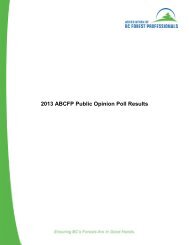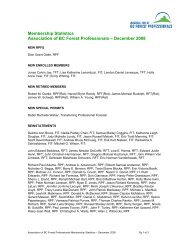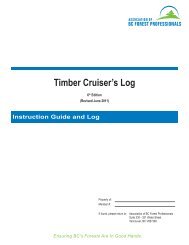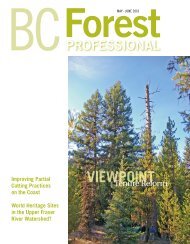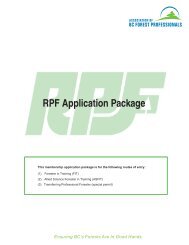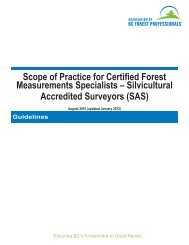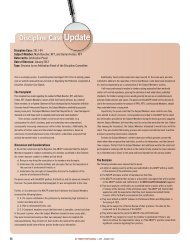VIEWPOINT - Association of BC Forest Professionals
VIEWPOINT - Association of BC Forest Professionals
VIEWPOINT - Association of BC Forest Professionals
You also want an ePaper? Increase the reach of your titles
YUMPU automatically turns print PDFs into web optimized ePapers that Google loves.
Viewpoints<br />
By John Davies, RPF<br />
Community Wildfire Protection Plans:<br />
Are They Making a Difference?<br />
Since 2004, the province has provided over $35 million to the<br />
community wildfire protection program (CWPP), which is administered<br />
through the Union <strong>of</strong> <strong>BC</strong> Municipalities (U<strong>BC</strong>M). To date, over 80 communities<br />
have completed a CWPP with more than $22 million being spent<br />
to develop these plans and to implement associated fuel management<br />
projects resulting from these reports.<br />
The overall objective stated within the U<strong>BC</strong>M application is,<br />
“to improve community safety and reduce the risk <strong>of</strong> property damage.”<br />
So…after five years and millions <strong>of</strong> dollars, are CWPPs providing<br />
wildfire protection?<br />
Developing a Community Wildfire Protection Program<br />
CWpp’s had their genesis in <strong>BC</strong> as a recommendation within the Filmon Report,<br />
commissioned by the province after the 2003 wildfire. in 2004, the protection branch<br />
initiated the CWpp with the program being administered through the Union <strong>of</strong> <strong>BC</strong><br />
Municipalities (U<strong>BC</strong>M).<br />
priority for funding is given to communities with supporting credible evidence <strong>of</strong><br />
having a moderate or higher wildfire risk. This is usually provided through pr<strong>of</strong>essional<br />
judgement, wildfire history, and/or the Strategic Threat Analysis data.<br />
The only requirements for being an author <strong>of</strong> a CWPP are that ‘fire/fuel behaviour<br />
expertise is solicited when the plan is prepared,’ appropriate methodologies are<br />
followed and an RPF must be involved ‘…if the plan will contain information regarding<br />
higher level plans, impact assessment or forest policy.’ it is imperative that the author<br />
have at least some wildfire and fuel management experience (regardless <strong>of</strong> having<br />
pr<strong>of</strong>essional accreditation), otherwise the result may be another academic plan that<br />
sits on a shelf. For forest pr<strong>of</strong>essionals, pr<strong>of</strong>essional reliance should shine through<br />
here with forester’s remaining within their scope <strong>of</strong> practice and not simply jumping on<br />
the fire management train due to available funding and lack <strong>of</strong> work elsewhere.<br />
A properly developed CWpp should contain a landscape level wildfire risk<br />
analysis, stand level interface fuel hazard assessments, and community specific<br />
recommendations for mitigating the wildfire risk and abating the interface fuel hazard.<br />
Additionally, the CWpp should consider a bylaw review that provides recommendations<br />
for directing the community towards a more FireSmart condition.<br />
20 <strong>BC</strong> FOREST PROFESSIONAL | MARCH - ApRil 2010<br />
Empirical evidence <strong>of</strong> the effectiveness <strong>of</strong> the CWPP and the associated<br />
fuel management projects is lacking. Obviously, unlike other<br />
forestry related research trials, the testing <strong>of</strong> CWPPs or fuel breaks will<br />
occur at the whim <strong>of</strong> the fire gods. Or, as is the case for roughly 50%<br />
<strong>of</strong> the fire starts in <strong>BC</strong>, at the whim <strong>of</strong> careless humans. One does not<br />
develop a CWPP, prescribe fuel treatments, implement them and then<br />
immediately test the effectiveness. At least one hopes this doesn’t happen.<br />
There have been research trials in the US and Northwest Territories<br />
where fuel breaks have been developed and tested. These can be compared<br />
to the results <strong>of</strong> interface fuel treatments; a desired operational<br />
outcome <strong>of</strong> a CWPP. Similarly, there are several cases <strong>of</strong> US wildfires<br />
burning into fuel breaks where the intended effect occurs and fire<br />
behaviour is reduced. Finally, there is a plethora <strong>of</strong> scientific literature<br />
regarding the positive impacts <strong>of</strong> interface fuel treatments. By this<br />
rational, any fuel management operations driven by prescriptions developed<br />
by forest pr<strong>of</strong>essionals with operational fire and fuel management<br />
experience should reduce fire behaviour within these treated areas.<br />
What is probably indisputable is that the heightened awareness <strong>of</strong><br />
communities and the leadership <strong>of</strong> government with regards to wildfire<br />
prevention in <strong>BC</strong> have increased since 2003. However, this awareness does<br />
tend to wane between the ‘big’ fire seasons. It is not enough to only pay<br />
attention to wildfires during the fire season, or worse, only during extreme<br />
seasons. Communities must address the risk year round through developing<br />
CWPP, treatment prescriptions, and most importantly, implementing<br />
interface fuel treatments. A plan has no impact if it is not implemented.<br />
There are two major impediments when transitioning a CWPP to<br />
the operational phase: no implementation strategy or no operational<br />
funding. The first impediment can be overcome by working with a forest<br />
pr<strong>of</strong>essional with operational fire and fuel management experience. This<br />
is where self-regulating scope <strong>of</strong> practice should occur, as well as reference<br />
checks by the client. With regards to funding, there is likely not a single<br />
local government in the province with the budget to undertake fuel management<br />
without funding assistance. Therefore, unless provincial and<br />
federal operational funding continues, the demise <strong>of</strong> properly prescribed<br />
and implemented fuel treatments will occur and fuel management will<br />
be marginalized or disappear altogether. That is until a wildfire destroys<br />
homes and it is once again politically motivating to wave the fire flag.<br />
We would do well to maintain this awareness and continue to<br />
aggressively pursue wildfire prevention and protection through the<br />
development <strong>of</strong> CWPPs and the implementation <strong>of</strong> fuel management<br />
projects. While public and local government interest may waver, the<br />
natural, integral role <strong>of</strong> wildfire in our ecosystems will not. The fire gods<br />
may rest some years but always return…<strong>of</strong>ten with a vengeance. 3<br />
John Davies owns Valhalla Consulting and works exclusively in the field <strong>of</strong><br />
wildfire management. He is a seasoned wildland fire fighter with over 17<br />
years <strong>of</strong> wildfire and fuel management experience.



